Euphorbia prostrata (Prostrate Spurge)
| Also known as: | |
|---|---|
| Genus: | Euphorbia |
| Family: | Euphorbiaceae (Spurge) |
| Life cycle: | annual |
| Origin: | south-central US |
| Habitat: | part shade, sun; dry, sandy or gravelly soil; lawns, gardens, sidewalk cracks, waste areas, roadsides, railroads |
| Bloom season: | July - October |
| Plant height: | .25 to 4 inches |
| Wetland Indicator Status: | none |
| MN county distribution (click map to enlarge): |  |
| National distribution (click map to enlarge): |  |
Pick an image for a larger view. See the glossary for icon descriptions.
Detailed Information
Flower: 


![[photo of flowers]](/udata/r9ndp23q/pd/euphorbia-prostrata-18-t.jpg) Flowers are very small, nearly indistinct, in small dense clusters in leaf axils on the upper side of spreading branches. A small cup, less than 1/16 inch across, holds the male and female flowers in the center.
Flowers are very small, nearly indistinct, in small dense clusters in leaf axils on the upper side of spreading branches. A small cup, less than 1/16 inch across, holds the male and female flowers in the center.
![[close-up of flowers]](/udata/r9ndp23q/pd/euphorbia-prostrata-15-3-t.jpg) The rim of the cup has 4 whitish to pink, minute petal-like appendages each with a thickened gland at the base that is pink to red. The male flower anthers are yellow and indistinct. The pistils of the single female flower in the center sit atop a round, three part ovary on a short stalk that extends out from the flower center. The structure of this flower is called a cyathium and common to all the Euphorbias
The rim of the cup has 4 whitish to pink, minute petal-like appendages each with a thickened gland at the base that is pink to red. The male flower anthers are yellow and indistinct. The pistils of the single female flower in the center sit atop a round, three part ovary on a short stalk that extends out from the flower center. The structure of this flower is called a cyathium and common to all the Euphorbias
Leaves and stems: 

![[photo of leaves and hairy stem]](/udata/r9ndp23q/pd/euphorbia-prostrata-23-t.jpg) Leaves are opposite, broadly oval-oblong to egg-shaped, mostly between ¼ and ½ inch long and half or more as wide, typically widest at or below the middle. Surfaces are sparsely covered with curled or crinkled white hairs, denser on the underside, edges minutely toothed, the tip rounded or bluntly pointed, the base rounded to heart-shaped and only slightly asymmetrical. Color is solid green to blue-green, without a red splotch mid-leaf, though sometimes purplish around the edge. Stems are up to 12 inches long, typically prostrate but occasionally ascending some, often reddish colored, sparsely to densely covered in curled or crinkled hairs, and branching frequently, forming large circular mats. Leaves and stems exude a milky sap when broken.
Leaves are opposite, broadly oval-oblong to egg-shaped, mostly between ¼ and ½ inch long and half or more as wide, typically widest at or below the middle. Surfaces are sparsely covered with curled or crinkled white hairs, denser on the underside, edges minutely toothed, the tip rounded or bluntly pointed, the base rounded to heart-shaped and only slightly asymmetrical. Color is solid green to blue-green, without a red splotch mid-leaf, though sometimes purplish around the edge. Stems are up to 12 inches long, typically prostrate but occasionally ascending some, often reddish colored, sparsely to densely covered in curled or crinkled hairs, and branching frequently, forming large circular mats. Leaves and stems exude a milky sap when broken.
Fruit: 
![[photo of fruit]](/udata/r9ndp23q/pd/euphorbia-prostrata-12-t.jpg) Fruit is a 3-lobed, stalked capsule, up to 2 mm long and 1.5 mm wide, with long, spreading hairs mostly along the angles, with only a few on the surface near the base. The capsule develops rapidly from the center of the cyathium, initially hanging down, becoming erect at maturity. Each lobe contains a single seed.
Fruit is a 3-lobed, stalked capsule, up to 2 mm long and 1.5 mm wide, with long, spreading hairs mostly along the angles, with only a few on the surface near the base. The capsule develops rapidly from the center of the cyathium, initially hanging down, becoming erect at maturity. Each lobe contains a single seed.
![[photo of seed]](/udata/r9ndp23q/pd/euphorbia-prostrata-15-1-t.jpg) Seeds are light brown with a white coating that easily rubs off, .8 to 1.1 mm long, sharply angular in cross-section, oval-oblong in outline, covered in minute pits on the surface with a few to several conspicuous transverse ridges.
Seeds are light brown with a white coating that easily rubs off, .8 to 1.1 mm long, sharply angular in cross-section, oval-oblong in outline, covered in minute pits on the surface with a few to several conspicuous transverse ridges.
Notes:
Prostrate Spurge is native to parts of the central and southern US into Mexico and South America, and considered adventive outside of that range. It is a recent introduction to Minnesota, currently known only from a single location: the railroad right-of-way at Long Lake Regional Park in Ramsey County. Characteristics that distinguish Prostrate Spurge from other mat-forming Spurges are: stems with curled or crinkled hairs; leaves that are hairy, finely serrated at least at the tip end, oval-oblong to broadly egg-shaped, rounded to heart-shaped and only slightly asymmetrical at the base, lacking a red splotch in the middle of the blade; capsules with long, spreading hairs mostly along the angles; seed with conspicuous transverse ridges. The only other hairy, mat-forming Spurge known to be in Minnesota is the common Spotted Spurge (Euphorbia maculata), which has leaves more oblong and strongly asymmetrical at the base, stem hairs are more spreading to ascending, capsules have short, appressed hairs across the surface, and seed lacks conspicuous transverse ridges. The 3 other mat-forming Minnesota Spurges, Geyer's Spurge (Euphorbia glyptrosperma), Ridge-seed Spurge (Euphorbia glyptrosperma) and Thyme-leaved Spurge (Euphorbia serphillifolia), are all hairless.
The similarity with E. maculata may have caused E. prostrata to be merely overlooked so it is possibly under-reported in the state; it happens. When we first encountered it, there was something that immediately struck us as different, though we couldn't put our finger on it at the time. It wasn't until we sent off our macro images to the experts in Atlanta that it became obvious what we had found. This species may well start moving along transportation corridors like so many other weeds have.
Native Plant Nurseries, Restoration and Landscaping Services ↓
More photos
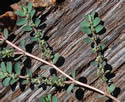 Prostrate Spurge plant
Prostrate Spurge plant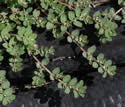 Prostrate Spurge plant
Prostrate Spurge plant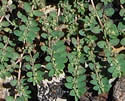 Prostrate Spurge plant
Prostrate Spurge plant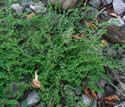 Prostrate Spurge plant
Prostrate Spurge plant Prostrate Spurge in a railroad right-of-way
Prostrate Spurge in a railroad right-of-way leaf hairs
leaf hairs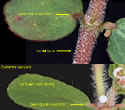 leaf/stem comparison of Euphorbia prostrata and E. maculata
leaf/stem comparison of Euphorbia prostrata and E. maculata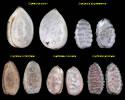 seed comparison of mat-forming Euphorbia species
seed comparison of mat-forming Euphorbia species
Photos by K. Chayka and Peter M. Dziuk taken in Ramsey County.
Comments
Have you seen this plant in Minnesota, or have any other comments about it?






